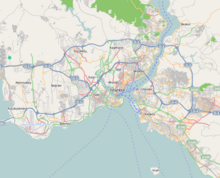Istanbul Archaeology Museums
| İstanbul Arkeoloji Müzeleri | |
 |
|
| Established | 13 June 1891 |
|---|---|
| Location | Osman Hamdi Bey Yokuşu Sokak, Gülhane, Istanbul, Turkey |
| Coordinates | 41°00′39″N 28°58′54″E / 41.010872°N 28.981659°E |
| Type | Archaeology museum |
| Collection size | 1+ million objects |
| Visitors | 382.148 (2011) |
| Director | Zeynep Kızıltan |
| Website | Istanbul Archaeology Museum page |
The Istanbul Archaeology Museums (Turkish: İstanbul Arkeoloji Müzeleri) is a group of three archeological museums located in the Eminönü district of Istanbul, Turkey, near Gülhane Park and Topkapı Palace.
The Istanbul Archaeology Museums consists of three museums:
It houses over one million objects that represent almost all of the eras and civilizations in world history.
In the 19th century, efforts were in place to modernize the Ottoman Empire, as many of the leading statesmen were exposed to Westernizing ideas through education and travel. The proposal to have an imperial museum came about because of the familiarity of several key players in the Ottoman political scene with the Louvre in Paris. The Ottoman sultan Abdülaziz (r. 1861–1876) was impressed by the archaeological museums in Paris (30 June – 10 July 1867),London (12–23 July 1867) and Vienna (28–30 July 1867) which he visited in the summer of 1867, and ordered a similar archaeological museum to be established in Istanbul. The decision to establish an Imperial Museum under the Education Ministry came in 1869 with the appointment of a new director, but the idea of a museum was dropped with his resignation and because of budget restraints.
As education minister in 1872, Ahmet Vefik Pasha set up a museum directorship for the second time and hired the German historian, archaeologist, epigraphist and painter, Dr. Phillip Anton Dethier. He proved to be so successful at collecting materials that the idea of a purpose-built museum gained traction.
When Dethier died in 1881, painter and archaeologist Osman Hamdi Bey was appointed to the position that same year.
...
Wikipedia

